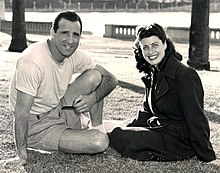Hank Greenberg
Henry Benjamin Greenberg (January 1, 1911 – September 4, 1986), nicknamed "Hammerin' Hank", "Hankus Pankus", and "the Hebrew Hammer", was an American professional baseball player and team executive.
In 1947, Greenberg signed a contract for a record $85,000 salary before being sold to the Pittsburgh Pirates, where he played his final MLB season that year.
After retiring from playing, Greenberg continued to work in baseball as a team executive for the Cleveland Indians and Chicago White Sox.
Detroit fans grumbled at the decision, however, with one reportedly saying, "Rosh Hashanah comes every year but the Tigers haven't won the pennant since 1909."
Guest expressed the general opinion in a poem titled "Came Yom Kippur: Speaking of Greenberg", in which he used the Irish (and thus Catholic) names Murphy and Mulroney.
[15] In April 1936, Greenberg re-injured his wrist in a collision with Jake Powell of the Washington Senators and did not play the remainder of the season.
He led the league in runs scored (144) and at-bats per home run (9.6), tied for the AL lead in walks (119), was second in RBIs (146), slugging percentage (.683), and total bases (380), and third in OBP (.438) and set a still-standing major league record of 39 homers in his home park, the newly re-configured Briggs Stadium.
He also set a major-league record with 11 multiple-home run games and came in third in the vote for MVP, behind Jimmie Foxx and Bill Dickey.
[7] After the 1939 season ended, Greenberg was asked by general manager Jack Zeller to take a salary cut of $5,000 ($110,000 today) as a result of his off-year in power and run production.
Greenberg in turn, demanded a $10,000 bonus if he mastered left field, insisting he was the one taking the risk in learning a new position.
In the spring of 1941, the Detroit draft board initially classified Greenberg as 4F for "flat feet" after his first physical for military service, and he was recommended for light duty.
The rumors that he had bribed the board, and concern that he would be likened to Jack Dempsey (who had received negative publicity for failure to serve in World War I), led Greenberg to request to be reexamined.
[22] On May 7, 1941, he was inducted into the U.S. Army after playing left field in 19 games, and reported to Fort Custer at Battle Creek, Michigan.
[23] In November, while serving as an anti-tank gunner, he was promoted to sergeant, but was honorably discharged on December 5 (the United States Congress released men aged 28 years and older from service), two days before Japan bombed Pearl Harbor.
[24] After the bombing of Pearl Harbor and the United States officially joining the war effort, Greenberg re-enlisted as a sergeant on February 1, 1942, and volunteered for service in the Army Air Forces, becoming the first major league player to do so.
[26] Greenberg, who played left field in 72 games and batted .311 in 1945, helped lead the Tigers to a come-from-behind American League pennant, clinching it with a dramatic grand slam home run in the ninth inning on the final day of the season against the St. Louis Browns, avoiding a one-game playoff against the now-second-place Washington Senators.
Since then, only Ted Williams (1960; 29), Dave Kingman (1986; 35), Mark McGwire (2001; 29), Barry Bonds (2007; 28) and David Ortiz (2016; 38) have hit as many or more homers in their final season.
When asked by the Tigers' front office to move to left field in 1940 to make room for Rudy York, he worked tirelessly to master that position as well, reducing his errors in the outfield from 15 in 1940 to 0 in 1945.
[36] Greenberg sometimes retaliated against the racial attacks, once going into the Chicago White Sox clubhouse and challenging manager Jimmy Dykes to a fight.
His decision to not play on Yom Kippur at a time of rampant antisemitism in the United States, and around the world, was significant and made him a hero in the American Jewish community.
When Veeck was forced to sell the Indians due to a divorce settlement, new owner Ellis Ryan retained Greenberg, promoting him to general manager.
Greenberg's contributions to the Cleveland farm system led to the team's successes throughout the 1950s, although Bill James once wrote that the Indians' late 1950s collapse should also be attributed to him.
"[43] While Ryan had initially been content to leave baseball matters to Greenberg, he tried to seize greater control after the 1952 season, when the Indians suffered a drop in attendance despite coming within two games of the pennant.
Under Wilson, Greenberg's role as operating head of the franchise was cemented to the point that he represented the Indians at owners meetings alongside vice president and board member George Medinger.
However, when Los Angeles Dodgers owner Walter O'Malley got wind of these developments, he threatened to scuttle the whole deal by invoking his exclusive rights to operate a major league team in southern California.
In truth, O'Malley wanted no part of competing against an expansion team owned by a master promoter such as Veeck, even if he was only a minority partner.
Greenberg later became a successful investment banker, briefly returning to baseball as a minority partner with Veeck when the latter repurchased the White Sox in 1975.
In 1966, Greenberg married actress Mary Jo Tarola, who appeared on-screen under the stage name "Linda Douglas", and remained with her until his death.
[63] In 2013, the Bob Feller Act of Valor Award honored Greenberg as one of 37 Baseball Hall of Fame members for his service in the United States Army Air Force during World War II.
[66] In 2010, he was again one of the main subjects of the film Jews and Baseball: An American Love Story, alongside Hall of Famer Sandy Koufax of the Los Angeles Dodgers.







